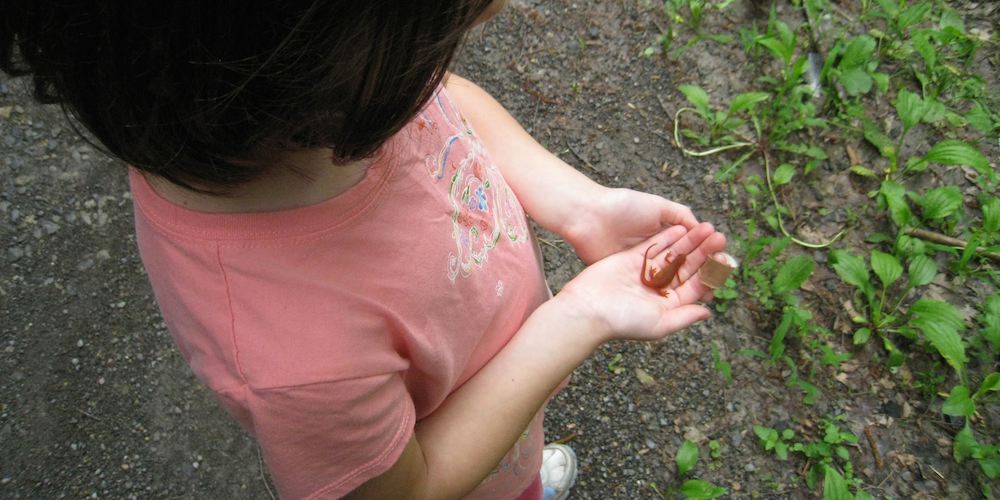This Martial Mama and her brood have just returned from a week in the Outer Banks, North Carolina. We and several extended family members (12 adults, seven kids, and one dog, in all) rented a spacious, near-the-beach house. Now, my husband and I have only had kids for just under a decade, so what future parenting trials we may undergo are, as yet, unknown to us. However, after a week with kids and parents in various stages, I have some insights about vacationing with wee ones.
Our kids are 6 and 9 years old. On this vacation, they got themselves dressed and fed themselves — the 9-year-old even got her own breakfast together. They helped pick up messes, generally hung out with us, and then pretty much entertained themselves. The other kids on this trip included my half-brother’s two kids (ages 7 and 8), my half-sister’s 5-month-old twin boys (adorable!), and my cousin’s 15-month-old son.
Going to the beach involved setting up our base camp — a bevy of umbrellas, tents, blankets, coolers, and beach toys — before everyone settled in to enjoy the beach. For my husband and me, this meant playtime in the waves with both kids, then a continuation of ocean time for my husband and son, while our daughter dug a “sand trap” a few feet away and I cracked open a book.
As I was reading and keeping half an eye on our daughter, I became aware of my cousin having to constantly manage her 15-month-old. Obviously, this is totally appropriate and necessary on account of how busy toddlers are and how dangerous a huge, surging sea can be for someone who is approximately 22 inches tall, has no fear, and thinks he can swim.
But, as I was reading my book, my cousin said to her son, “Look at Aunt Jenn.” (Technically, I’m his first cousin once removed, but “aunt” is more practical, given the 30-plus-year age gap). “Just look how relaxed she is. She’s reading a book. I would love to just read a book!”
This made me smile as I looked up and saw her, yet again, making a move to keep her little human tornado safe. Then she said to me, “I know, I know … you’ve earned it!”
I told her that, in fact, this was really the first vacation we’ve taken since having kids that we could sort of relax and enjoy ourselves. And I remembered well when our kids were toddlers, how we were never able to just sit down. I also told her that, naturally, this would be the case for her, too, and she could read a book in just a few years. (And, while I didn’t say it out loud, I have earned it!)
My husband and I have experienced five stages of traveling with kids. The infant stage, in my opinion, is one of the easiest times. Sure, babies wake up more frequently at night and sometimes they cry but they also sleep a lot, stay where you put them, and don’t generally care where they are as long as they are fed, changed, and held. This stage might be a little more challenging for parents who bottle-feed, but nursing moms have it easy in this regard. Plus, if you travel with family or close friends, they won’t be able to keep their hands off of a baby, so you will have some free time between feedings and changings.
The toddler stage, unfortunately for my cousin right now, is probably one of the most challenging times to travel with kids. I am pretty sure toddlers cry more than infants because they are constantly hearing the word “No.” They do care where they are, and they require a lot of gear, which they don’t have to carry, pack, and remember. If you forget a critical item (a lovey, special spoon, music box, etc.), your toddler will remember, and the rest of your trip will be much less enjoyable. And don’t even think about trying to buy a replacement, because your toddler will know. Also, no matter if you are home or away, during the toddler stage, you are a prisoner to the morning and afternoon naps. So, spending a whole day anywhere away from a sleeping space is out of the question.
The preschool stage is fun if you go to a super-kid-friendly place. (But not too much of a kid-friendly place, like anywhere that your preschoolers will have to wait excessively long to enjoy an activity. If they have to wait and watch other kids having fun, you are pretty much guaranteed a meltdown of epic proportions.) At this stage, a morning nap may be a thing of the past, but the afternoon nap is still critical. So, during this phase, plan to get to things early, and plan to leave before nap time. This is usually a stage when you can go out to (an early) dinner pretty much anywhere, excluding very formal or fancy restaurants. My point is, just because you have toddlers, you are not restricted to Friendly’s or McDonald’s for your dining needs.
Traveling with young kids (ages 5 to 7) gets even easier. Even though young kids may have an earlier bedtime, naps are probably totally gone by now. You can go to places you enjoy, as long as you keep extended stops to a minimum (no pondering that blank canvas at the Museum of Modern Art for longer than 15 seconds) and keep your kid(s) engaged. Talk to them about the things they are seeing, and ask them focused questions. For instance, instead of saying, “Isn’t this cool?!” you might try, “What would you paint on this blank canvas?” Young kids aren’t going to have the stamina or the patience that you have for your interests, but they tend to be tolerant. It is wise, during this time, to try and schedule some kid-friendly activities in between your antique hunting and gallery gazing.
My husband and I are now in the full-fledged “Traveling with Kids” stage, which I would categorize as involving children between the ages of 7 and 12-ish. Our son is on the very bottom of this age range (almost 7) and our daughter is nearing age 10. They are joys to travel with. They are extremely tolerant of long car rides. When they are sick of talking to us, they will draw, read a book, watch a movie, or play games on their Kindles. It took us 12 hours to drive home from our vacation this year, and I can tell you that the kids did way better than I did! Traveling, to them, is a grand adventure.
Our kids enjoy museums, tours, and sightseeing a whole lot more than they did a few years ago. They understand things, make connections, and ask questions. Also, they are far more likely to stop and really experience something before feeling the need to run to the next fun thing. There actually were a few times on this trip when we got bored with something before the kids did, and that is definitely a first for us.
I’m not going to lie — it is easier to travel with kids who can pull their own luggage and read to themselves. But traveling with any kid, big or small, while it maybe not as leisurely as it was before kids, can be a really fun experience, too. And it might not be as bad as you think.










